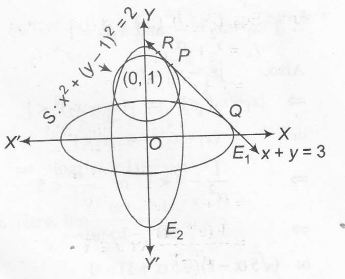Answer:
Option C,D
Explanation:
Here, $E_{1}:\frac{x^{2}}{a^{2}}+\frac{y^{2}}{b^{2}}=1,(a>b)$

$E_{2}:\frac{x^{2}}{c^{2}}+\frac{y^{2}}{d^{2}}=1,(c<d)$
and $S:x^{2}+(y-1)^{2}=2$
as tangent to E1 ,E2 and S is x+y=3.
Let the point of contact of tangent be (x1,y1) to S.
$\therefore$ x.x1+y.y1-(y+y1)+1=2
or $xx_{1}+yy_{1}-y=(1+y_{1})$ , same as x+y=3.
$\Rightarrow$ $\frac{x_{1}}{1}=\frac{y_{1}-1}{1}=\frac{1+y_{1}}{3}$
i.e, x1=1 and y1=2
$\therefore$ P= (1,2)
Since, PR= PQ= $\frac{2\sqrt{2}}{3}$. thus by parametric form.
$\frac{x-1}{-1/\sqrt{2}}=\frac{y-2}{1/\sqrt{2}}=\pm\frac{2\sqrt{2}}{3}$
$\Rightarrow $ $\left(x=\frac{5}{3},y=\frac{4}{3}\right)$
and $ \left(x=\frac{1}{3},y=\frac{8}{3}\right)$
$\therefore$ $ Q=\left(\frac{5}{3},\frac{4}{3}\right)$ and $R= \left(\frac{1}{3},\frac{8}{3}\right)$
Now, equation of tangent at Q on ellipse E1 is
$\frac{x.5}{a^{2}.3}+\frac{y.4}{b^{2}.3}=1$
On comparing with x+y=3, we get
a2 =5 and b2=4
$\therefore$ $e_1^2=1-\frac{b^{2}}{a^{2}}=1-\frac{4}{5}=\frac{1}{5}$ ......(i)
Also equation of tangent at R on ellipse E2 is
$\frac{x.1}{a^{3}.3}+\frac{y.8}{b^{2}.3}=1$
On comparing with x+y=3, we get
a2=1, b2=8
$\therefore$ $e_2^2=1-\frac{a^{2}}{b^{2}}=1-\frac{1}{8}=\frac{7}{8}$ ......(ii)
Now, $e_1^2 .e_2^2=\frac{7}{40}\Rightarrow e_{1}e_{2}=\frac{\sqrt{7}}{2\sqrt{10}}$
and $e_1^2+e_2^2=\frac{1}{5}+\frac{7}{8}=\frac{43}{40}$
$|e_1^2+e_2^2|=|\frac{1}{5}-\frac{7}{8}|=\frac{27}{40}$